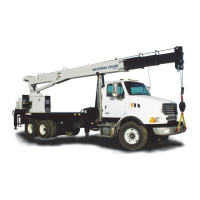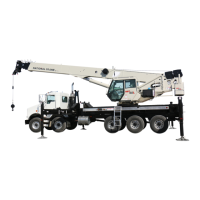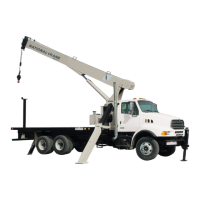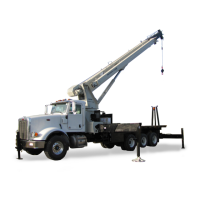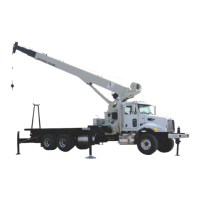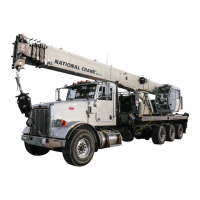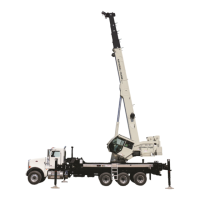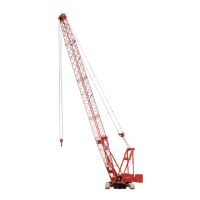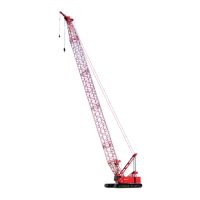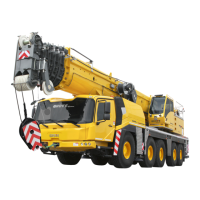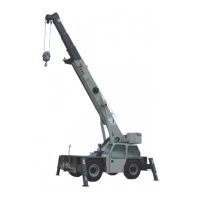Published 08/16/19 Control # 112-05 1-5
500E2 SERVICE MANUAL INTRODUCTION
National Crane
Hydraulic Lines
When disconnecting hoses, tag each one to ensure proper
identification during
assembly.
When installing metal tubes, tighten all bolts finger-tight.
Then, in order, tighten the bolts at the rigid end, the
adjustable end, and the mounting brackets. After tubes are
mounted, install the hoses. Connect both ends of the hose
with all bolts finger-tight. Position the hose so it does not rub
the machine or another hose and has a minimum of bending
and twisting. Tighten bolts in both couplings.
Due to manufacturing methods there is a natural curvature to
a hydraulic hose. Reinstall the hose so any bend is with this
curvature.
ELECTRICAL
Batteries
Clean the batteries with a solution of baking soda and water.
Rinse with clear water and dry. Clean the battery terminals
with fine sandpaper and coat the terminals dielectric grease.
Do not use a non-dielectric grease.
Remove the batteries If the machine is not used for an
extended period of time. Store the batteries in a warm, dry
place, preferably on wooden shelves. Never store on
concrete. A small charge should be introduced periodically to
keep the specific gravity rating at recommended level.
When disconnecting wires, tag each one to ensure proper
identification during re
assembly.
Jump Starting Hazard
Do not attempt to jump start the crane.
This crane has multiple computer systems (crane control,
RCL, engine & transmission control) that are highly
susceptible to voltage/amperage surges in the electrical
system.
The batteries should be completely disconnected from the
crane electrical system and charged using a battery charger
of appropriate voltage level or replace the batteries with fully
charged batteries. Refer to Charging the Batteries, page 1-5.
Charging the Batteries
When charging the batteries, do not turn on the battery
charger until the charging leads have been connected to the
battery(s). Also, if the battery(s) are found to be frozen, do
not attempt to charge them. Remove the battery(s) from the
crane, allow them to thaw, and then charge the battery(s) to
full capacity.
“Slow charging” is preferred to “fast charging”. Fast charging
saves time but risks overheating the battery(s). Slow
charging at six (6) amps or less develops less heat inside the
battery and breaks up the sulfate on the battery plates more
efficiently to bring the battery up to full charge. The use of a
“smart charger” that automatically adjusts the charging
amperage rate should be used.
Connectors, Harnesses, Wires, and
Connectors
Visually inspect all electrical harnesses, cables, and
connectors every month or 250 hours for the following:
• Damaged, cut, blistered, or cracked insulation.
• Exposed bare wires.
• Kinked or crushed wires and cables.
• Cracked or corroded connectors, battery terminals, and
ground connections.
If any, the above conditions exist, evaluate, and replace as
necessary.
The climate in which the crane operates affects the service
life of the electrical components. The climate zones are
defined in the table on page 1-6. Recommended
replacement of harness and cables is as follows:
• Climate zone C after 10,000 hours of service.
• Climate zones A and C with high ambient temperatures
and duty cycles after 8000 hours of service.
• Climate zones D and E after 10,000 hours of service.
• Salt water conditions after 8,000 hours of service.
CAUTION
Disconnect batteries prior to working on the electrical
system.
CAUTION
It is strongly recommended that the batteries not be
“jumped” with a different vehicle, portable power pack,
etc. The surge of power from these sources can
irreparably damage the various electronic controls and
computer systems. Jump starting the crane batteries
with a different vehicle while the engine is running can
damage the donor vehicle electronics as well if done
improperly.

